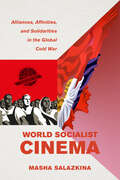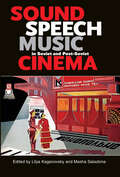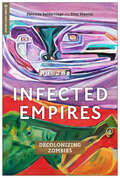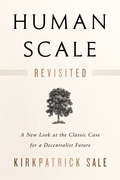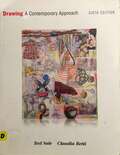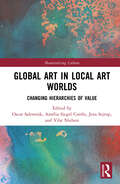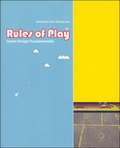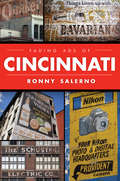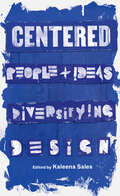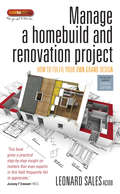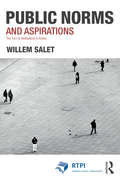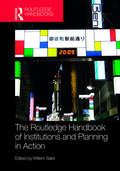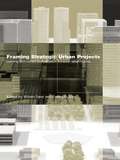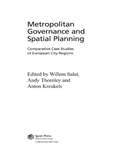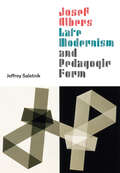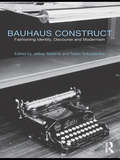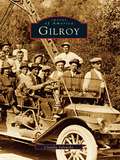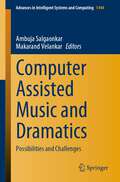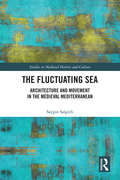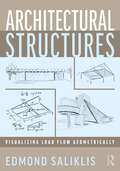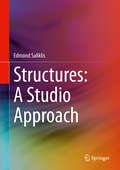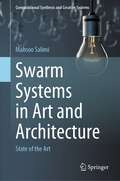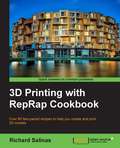- Table View
- List View
World Socialist Cinema: Alliances, Affinities, and Solidarities in the Global Cold War (Cinema Cultures in Contact #4)
by Masha SalazkinaA free ebook version of this title is available through Luminos, University of California Press’s Open Access publishing program. Visit www.luminosoa.org to learn more. In this capacious transnational film history, renowned scholar Masha Salazkina proposes a groundbreaking new framework for understanding the cinematic cultures of twentieth-century socialism. Taking as a point of departure the vast body of work screened at the Tashkent International Festival of Cinemas of Asia, Africa, and Latin America in the 1960s and 1970s, World Socialist Cinema maps the circulation of films between the Soviet Bloc and the countries of the Global South in the mid- to late twentieth century, illustrating the distribution networks, festival circuits, and informal channels that facilitated this international network of artistic and intellectual exchange. Building on decades of meticulous archival work, this long-anticipated film history unsettles familiar stories to provide an alternative to Eurocentric, national, and regional narratives, rooted outside of the capitalist West.
Sound, Speech, Music in Soviet and Post-Soviet Cinema
by Masha Salazkina Lilya KaganovskyThis innovative volume challenges the ways we look at both cinema and cultural history by shifting the focus from the centrality of the visual and the literary toward the recognition of acoustic culture as formative of the Soviet and post-Soviet experience. Leading experts and emerging scholars from film studies, musicology, music theory, history, and cultural studies examine the importance of sound in Russian, Soviet, and post-Soviet cinema from a wide range of interdisciplinary perspectives. Addressing the little-known theoretical and artistic experimentation with sound in Soviet cinema, changing practices of voice delivery and translation, and issues of aesthetic ideology and music theory, this book explores the cultural and historical factors that influenced the use of voice, music, and sound on Soviet and post-Soviet screens.
Infected Empires: Decolonizing Zombies (Global Media and Race)
by Patricia Saldarriaga Emy ManiniGiven the current moment--polarized populations, increasing climate fears, and decline of supranational institutions in favor of a rising tide of nationalisms-- it is easy to understand the proliferation of apocalyptic and dystopian elements in popular culture. Infected Empires examines one of the most popular figures in contemporary apocalyptic film: the zombie. This harbinger of apocalypse reveals bloody truths about the human condition, the wounds of history, and methods of contending with them. Infected Empires considers parallels in the zombie genre to historical and current events on different political, theological and philosophical levels, and proposes that the zombie can be read as a figure of decolonization and an allegory of resistance to oppressive structures that racialize, marginalize, disable, and dispose of bodies. Studying films from around the world, including Latin America, Asia, Africa, the US, and Europe, Infected Empires presents a vision of a global zombie that points toward a posthuman and feminist future.
Human Scale Revisited: A New Look at the Classic Case for a Decentralist Future
by Kirkpatrick SaleBig government, big business, big everything: Kirkpatrick Sale took giantism to task in his 1980 classic, Human Scale, and today takes a new look at how the crises that imperil modern America are the inevitable result of bigness grown out of control—and what can be done about it. The result is a keenly updated, carefully argued case for bringing human endeavors back to scales we can comprehend and manage—whether in our built environments, our politics, our business endeavors, our energy plans, or our mobility. Sale walks readers back through history to a time when buildings were scaled to the human figure (as was the Parthenon), democracies were scaled to the societies they served, and enterprise was scaled to communities. Against that backdrop, he dissects the bigger-is-better paradigm that has defined modern times and brought civilization to a crisis point. Says Sale, retreating from our calamity will take rebalancing our relationship to the environment; adopting more human-scale technologies; right-sizing our buildings, communities, and cities; and bringing our critical services—from energy, food, and garbage collection to transportation, health, and education—back to human scale as well. Like Small is Beautiful by E. F. Schumacher, Human Scale has long been a classic of modern decentralist thought and communitarian values—a key tool in the kit of those trying to localize, create meaningful governance in bioregions, or rethink our reverence of and dependence on growth, financially and otherwise. Rewritten to interpret the past few decades, Human Scale offers compelling new insights on how to turn away from the giantism that has caused escalating ecological distress and inequality, dysfunctional governments, and unending warfare and shines a light on many possible pathways that could allow us to scale down, survive, and thrive.
Drawing: A Contemporary Approach
by Teel Sale Claudia BettiDRAWING: A CONTEMPORARY APPROACH takes you beyond conventional approaches, emphasizing the emotional, intellectual, spiritual, and social significance of art. The authors trace the evolution of today's art from that of the past, showing drawing's meaning and continuity. DRAWING: A CONTEMPORARY APPROACH offers a combination of effective pedagogy, good exercises, and high-quality, contemporary drawings as models, focusing on contemporary artists who draw in a multicultural world
Global Art in Local Art Worlds: Changing Hierarchies of Value (Materializing Culture)
by Oscar Salemink Amélia Siegel Corrêa Jens Sejrup Vibe NielsenThis book explores the attribution and local negotiation of cultural valuations of artistic and art-institutional practices around the world, and considers the diverse ways in which these value attributions intersect with claims of universality and cosmopolitanism. Taking Michael Herzfeld’s notion of the “global hierarchy of value” as point of departure, the volume brings together six empirical studies of the collection, circulation, classification and exhibition of objects in present-day Brazil, China, India, Japan, South Africa and Indigenous Australia in light of Europe’s loss of global hegemony. Including reflections by a number of senior scholars, the chapters demonstrate that the question of valuation lies at the heart of artistic and art-institutional practices writ large – including museum practices, museum architecture, galleries, auction houses, art fairs and biennales.
Rules of Play: Game Design Fundamentals (The\mit Press Ser.)
by Katie Salen Tekinbas Eric ZimmermanAn impassioned look at games and game design that offers the most ambitious framework for understanding them to date.As pop culture, games are as important as film or television—but game design has yet to develop a theoretical framework or critical vocabulary. In Rules of Play Katie Salen and Eric Zimmerman present a much-needed primer for this emerging field. They offer a unified model for looking at all kinds of games, from board games and sports to computer and video games. As active participants in game culture, the authors have written Rules of Play as a catalyst for innovation, filled with new concepts, strategies, and methodologies for creating and understanding games. Building an aesthetics of interactive systems, Salen and Zimmerman define core concepts like "play," "design," and "interactivity." They look at games through a series of eighteen "game design schemas," or conceptual frameworks, including games as systems of emergence and information, as contexts for social play, as a storytelling medium, and as sites of cultural resistance.Written for game scholars, game developers, and interactive designers, Rules of Play is a textbook, reference book, and theoretical guide. It is the first comprehensive attempt to establish a solid theoretical framework for the emerging discipline of game design.
Fading Ads of Cincinnati
by Ronny SalernoHidden down alleyways, on street corners or on the bricks above the cityscape, Cincinnati's fading advertisements hide in plain sight. These ghost signs still tout their wares and services, remnants of a bygone era. Each sign has a vivid story behind it unique to its era, product and craftsmanship. "Wall dogs" like sign artist Gus Holthaus left their marks on the city. A sign for the Beehive, the club and restaurant at the top of the arena, reminds residents of Cincinnati's pro hockey team, the Stingers. Not many can remember "the Other Place," but a hand-painted advertisement still adorns a city wall. Join author and photographer Ronny Salerno for a tour of Cincinnati's vanishing signs and their intriguing history.
Centered: People and Ideas Diversifying Design
by Kaleena SalesA rich, inclusive, contemporary, and global look at design diversity, past and present, through essays, interviews, and images curated by design educator and advocate Kaleena Sales.As the design industry reexamines its emphasis on Eurocentric ideologies and wrestles with its conventional practices, Centered advocates for highlighting and giving a voice to the people, places, methods, ideas, and beliefs that have been eclipsed or excluded by dominant design movements.Curated by Kaleena Sales, a powerful voice and noted advocate for diversity in the design community, the thirteen essays and interviews in this volume feature important and underrepresented design work and projects, both historical and present-day, including:Gee's Bend Quilters, by Stephen Child and Isabella D'AgnenicaA Chinese Typographic Archive, by YuJune Park and Caspar Lam Indigenous Sovereignty and Design: An Interview with Sadie Red Wing (Her Shawl is Yellow)The Truck Art of India, by Shantanu SumanNew Lessons from the Bauhaus: An Interview with Ellen Lupton Vocal Type: An Interview with Tré SealsDecolonizing Graphic Design, A Must, by Cheryl D. Miller And moreFilled with striking visuals from a range of global designers, Centered is a must-read and must-have for design practitioners, educators, students, and anyone interested in expanding narratives and gaining a more inclusive understanding of design diversity and its impact on culture.
Manage A Home Build And Renovation Project 4th Edition: How To Fulfil Your Own Grand Design
by Leonard SalesUndertaking a building or renovation project can be a bit daunting. But with the help of this book you will be in control at all times, confident in your decision making, and sure of getting the job done on time and to a high standard. It includes proven and simple-to-use management techniques that would suit projects ranging from one thousand to one million pounds.Contents: Introduction; About the author; 1. Getting started; 2. Know your requirements; 3. Contacting contractors; 4. Establishing credibility; 5. Obtaining and agreeing quotes; 6. Starting the work; 7. Financial arrangements; 8. Operation and maintenance manuals; 9. Good working relations; 10. Record-keeping; 11. Professional and site teams; Index
Manage A Home Build And Renovation Project 4th Edition: How to fulfil your own grand design
by Leonard SalesUndertaking a building or renovation project can be a bit daunting. But with the help of this book you will be in control at all times, confident in your decision making, and sure of getting the job done on time and to a high standard. It includes proven and simple-to-use management techniques that would suit projects ranging from one thousand to one million pounds.Contents: Introduction; About the author; 1. Getting started; 2. Know your requirements; 3. Contacting contractors; 4. Establishing credibility; 5. Obtaining and agreeing quotes; 6. Starting the work; 7. Financial arrangements; 8. Operation and maintenance manuals; 9. Good working relations; 10. Record-keeping; 11. Professional and site teams; Index
Public Norms and Aspirations: The Turn to Institutions in Action (RTPI Library Series)
by Willem SaletThe aspirations of individuals, organizations, and states, and their perceptions of problems and possible solutions circulate fast in this instantaneous society. Yet, the deliberation of the underlying public norms seems to escape the attention of the public. Institutions enable people to have reliable expectations of one another even when they are unsure of each other's aspirations and purposes. Public norms enable people to act under conditions of increasing uncertainty. To fulfill this role in society, institutions need enhancement, maintenance, and innovation. Public Norms and Aspirations aims to improve the methodology of planning research and practice by exploring the co-evolution of institutional innovation and the philosophy of pragmatism in processes of action. As most attention in planning research and planning practices goes to the pragmatic approaches of aspirations and problem solving, the field is awaiting an upgrade of institutional perspectives. This book aims to explore the interaction of institutional and pragmatic thought and to suggest how these two approaches might be integrated and applied in successful planning research. Searching this combination at the interface of sociology, planning, and law, Salet opens a unique niche in the existing planning literature.
The Routledge Handbook of Institutions and Planning in Action
by Willem SaletThe Routledge Handbook of Institutions and Planning in Action contains a selection of 25 chapters prepared by specialized international scholars of urban planning and urban studies focusing on the question of how institutional innovation occurs in practices of action. The contributors share expertise on institutional innovation and philosophical pragmatism. They discuss the different facets of these two conceptual frameworks and explore the alternative combinations through which they can be approached. The relevance of these conceptual lines of thought will be exemplified in exploring the contemporary practices of sustainable (climate-proof) urban transition. The aim of the handbook is to give a boost to the turn of institutional analysis in the context of action in changing cities. Both philosophical pragmatism and institutional innovation rest on wide international uses in social sciences and planning studies, and may be considered as complementary for many reasons. However, the combination of these different approaches is all but evident and creates a number of dilemmas. After an encompassing introductory section entitled Institutions in Action, the handbook is further divided into the following sections: Institutional innovation Pragmatism: The Dimension of Action On Justification Cultural and Political Institutions in Action Institutions and Urban Transition
Framing Strategic Urban Projects: Learning from current experiences in European urban regions
by Willem Salet Enrico GualiniPresenting the findings of extensive research into the development of planning tools and strategies since the early 1970s, this book addresses key issues in urban development/governance and brings together a range of different national experiences. Helpfully divided into three sections, Framing Strategic Urban Projects sets out the study framework, with its social, policy and institutional contexts; uses up-to-date European case studies to highlight different planning issues, including new-urbanism, information networks and public partnerships; and finally makes good-practice recommendations. Offering a systematic comparison of a wide variety of projects and providing useful case study material of these large-scale urban projects and recommendations, this book is essential reading for planners, policy makers and students interested in how to make strategic urban projects work effectively.
Metropolitan Governance and Spatial Planning: Comparative Case Studies of European City-Regions
by Willem Salet Andy Thornley Anton KreukelsMetropolitan Governance and Spatial Planning explores the relationship between metropolitan decision-making and strategies to co-ordinate spatial policy. This relationship is examined across 20 cities of Europe and the similarities and differences analysed.Cities are having to formulate their urban policies in a very complex and turbulent environment. They are faced with numerous new pressures and problems and these often create contradictory conditions. The book provides a theoretical framework for exploring these issues and links this to a detailed investigation of each city. In the context of globalisation, cities in the last twenty years have experienced new patterns of activity and these usually transcend political boundaries. The management of these changes therefore requires an effort of co-ordination and different cities have found different approaches.However the institutional setting itself has not remained static. The nation states in Europe have handed over many responsibilities to the European Union while also increasing devolution to regions and cities. Government has therefore become a more complex multi-level activity.There has also been the move from government to governance. Many different public, quasi-public and private bodies are now involved in making decisions that affect urban development. Metropolitan governance is therefore also a complex multi-actor process.In these conditions of fragmented governance and the widening spatial networking of urban development, the issue of policy co-ordination become ever more important. The exploration of the 20 cities shows that many face similar difficulties while some also provide interesting examples of innovative practice. The book concludes that the way forward is to find strategies to link the different spheres of metropolitan action through 'organising connectivity'.
Josef Albers, Late Modernism, and Pedagogic Form
by Jeffrey SaletnikAn incisive analysis of the pedagogy of influential artist and teacher Josef Albers. An extraordinary teacher whose influence continues today, Josef Albers helped shape the Bauhaus school in Germany and established the art and design programs at Black Mountain College in North Carolina and Yale University. His books about color theory have informed generations, and his artworks are included in the canon of high-modernist non-representational art. The pedagogy Albers developed was a dynamic approach to teaching that transcended the modernist agendas and cultivated a material way of thinking among his students. With this book, Jeffrey Saletnik explores the origins of Albers’s teaching practices and their significance in conveying attitudes about form, material, and sensory understanding to artists Eva Hesse and Richard Serra. He demonstrates how pedagogy is a framework that establishes the possibility for artistic discourse and how the methods through which artists learn are manifested in their individual practices. Tracing through lines from Albers’s training in German educational traditions to his influence on American postwar art, Josef Albers, Late Modernism, and Pedagogic Form positions Albers’s pedagogy as central to the life of modernism.
Josef Albers, Late Modernism, and Pedagogic Form
by Jeffrey SaletnikAn incisive analysis of the pedagogy of influential artist and teacher Josef Albers. An extraordinary teacher whose influence continues today, Josef Albers helped shape the Bauhaus school in Germany and established the art and design programs at Black Mountain College in North Carolina and Yale University. His books about color theory have informed generations, and his artworks are included in the canon of high-modernist non-representational art. The pedagogy Albers developed was a dynamic approach to teaching that transcended the modernist agendas and cultivated a material way of thinking among his students. With this book, Jeffrey Saletnik explores the origins of Albers’s teaching practices and their significance in conveying attitudes about form, material, and sensory understanding to artists Eva Hesse and Richard Serra. He demonstrates how pedagogy is a framework that establishes the possibility for artistic discourse and how the methods through which artists learn are manifested in their individual practices. Tracing through lines from Albers’s training in German educational traditions to his influence on American postwar art, Josef Albers, Late Modernism, and Pedagogic Form positions Albers’s pedagogy as central to the life of modernism.
Bauhaus Construct: Fashioning Identity, Discourse and Modernism
by Jeffrey Saletnik Robin SchuldenfreiReconsidering the status and meaning of Bauhaus objects in relation to the multiple re-tellings of the school’s history, this volume positions art objects of the Bauhaus within the theoretical, artistic, historical, and cultural concerns in which they were produced and received. Contributions from leading scholars writing in the field today – including Frederic J. Schwartz, Magdalena Droste, and Alina Payne – offer an entirely new treatment of the Bauhaus. Issues such as art and design pedagogy, the practice of photography, copyright law, and critical theory are discussed. Through a strong thematic structure, new archival research and innovative methodologies, the questions and subsequent conclusions presented here re-examine the history of the Bauhaus and its continuing legacy. Essential reading for anyone studying the Bauhaus, modern art and design.
Gilroy
by Claudia SalewskeLocated along the El Camino Real at the crossroads of the Pacheco and Hecker Pass highways, Gilroy is surrounded by the rich farmland of southern Santa Clara County. The region boasts a mineral hot springs, prime grazing land in the eastern foothills, and redwood forests to the west. In addition to successful lumbering enterprises, vast cattle ranches, and thriving resorts, Gilroy claims to be "The Garlic Capital of the World." From the early settlements of the Ohlone, through the vibrant Rancho era and post "gold-fever" boom, to the present-day world-famous Garlic Festival, this book illustrates the unique history of this town at the southern end of Silicon Valley. Drawn from the archives of the Gilroy Museum and the albums of pioneer families are more than 200 vintage images of the businesses, dwellings, pastimes, hopes, and high-jinks of the individuals who made Gilroy what it is today.
Computer Assisted Music and Dramatics: Possibilities and Challenges (Advances in Intelligent Systems and Computing #1444)
by Ambuja Salgaonkar Makarand VelankarThis book is intended for researchers interested in using computational methods and tools to engage with music, dance and theatre. The chapters have evolved out of presentations and deliberations at an international workshop entitled Computer Assisted Music and Dramatics: Possibilities and Challenges organized by University of Mumbai in honour of Professor Hari Sahasrabuddhe, a renowned educator and a pioneering computational musicologist (CM) of Indian classical music. The workshop included contributions from CM as well as musicians with a special focus on South Asian arts. The case studies and reflective essays here are based on analyses of genres, practices and theoretical constructs modelled computationally. They offer a balanced and complementary perspective to help innovation in the synthesis of music by extracting information from recorded performances. This material would be of interest to scholars of the sciences and humanities and facilitate exchanges and generation of ideas.
The Fluctuating Sea: Architecture and Movement in the Medieval Mediterranean (Studies in Medieval History and Culture)
by Saygin SalgirliThis volume fluctuates between conceptualizations of movement; either movements that buildings in the medieval Mediterranean facilitated, or the movements of the users and audiences of architecture. From medieval Anatolia to Southern France and the Genoese colony of Pera across Constantinople, The Fluctuating Sea investigates how the relationship between movement and the experiences of a multiplicity of users with different social backgrounds can provide a new perspective on architectural history. The book acknowledges the shared characteristics of medieval Mediterranean architecture, but it also argues that for the majority of people inhabiting the fragmented microecologies of the Mediterranean, architecture was a highly localized phenomenon. It is the connectivity of such localized experiences that The Fluctuating Sea uncovers. The Fluctuating Sea is a valuable source for students and scholars of the medieval Mediterranean and architectural history.
Architectural Structures: Visualizing Load Flow Geometrically
by Edmond SaliklisArchitectural Structures presents an alternative approach to understanding structural engineering load flow using a visually engaging and three-dimensional format. This book presents a ground-breaking new way of establishing equilibrium in architectural structures using the Modern Müller-Breslau method. While firmly grounded in principles of mechanics, this method does not use traditional algebraic statics, nor does it use classical graphic statics. Rather, it solely uses new geometric tools. Both statically determinate and statically indeterminate structures are analyzed using this graphic method to provide a geometric understanding of how load flows through architectural structures. This book includes approachable coverage of parametric modeling of two-dimensional and three-dimensional structures, as well as more advanced topics such as indeterminate structural analysis and plastic analysis. Hundreds of detailed drawings created by the author are included throughout to aid understanding. Architecture and structural engineering students can employ this novel method by hand sketching, or by programming in parametric design software. A detailed yet approachable guide, Architectural Structures is ideal for students of architecture, construction management, and structural engineering, at all levels. Practitioners will find the method extremely useful for quickly solving load tracing problems in three-dimensional grids.
Structures: A Studio Approach
by Edmond SaliklisUnderstanding how gravity loads and wind and earthquake loads flow through a building is of utmost importance to all structural engineers and architects. Paradoxically, this critical idea is practically not addressed in any textbook on the market. Meant as a companion to the author’s Structures: A Geometric Approach, this textbook fills that need with qualitative techniques as well as quantitative tools that use state of the art visual representation of forces and deformations in structures. Structures: A Studio Approach reaches out to both structural engineers and designers by presenting structural engineering topics in an interdisciplinary studio environment. Using many graphical techniques, it offers a very rigorous approach, but also enables creativity. Cutting edge finite element as well as parametric modeling tools are used, and state of the art visual representations of force flow help both groups of students realize that understanding three dimensional load flow in a building is a requirement for channeling that flow in a structurally efficient and visually expressive manner. Ultimately, the reader is able to develop a unique structural sensibility; an ethos that places structural design on an equal footing with the design of program, skin, massing and site.
Swarm Systems in Art and Architecture: State of the Art (Computational Synthesis and Creative Systems)
by Mahsoo SalimiThis book presents the recent computational developments inspired by swarms in art known as swarm art and discusses applying swarm intelligence concepts in architecture. Non-human art is a great leap in the evolution of contemporary art, removing the requirement of an artist’s production from the creative process. Furthermore, it is a critical declaration in opposition to the anthropomorphic vision which is so destructive for all other life forms and the planet’s ecology. When accepted and integrated into human culture, non-human art done by artificial systems or machines boosts creativity and stimulates innovative fusions. We analyze 120 swarm systems with unique and diverse conceptual contexts, agent design, and audience engagement that can be utilized as inspiration for future projects or to design new swarm algorithms by artists, architects, or computer scientists.
3D Printing with RepRap Cookbook
by Richard SalinasA systematic guide consisting of over 100 recipes which focus on helping you understand the process of 3D printing using RepRap machines. The book aims at providing professionals with a series of working recipes to help make their fuzzy notions into real, saleable projects/objects using 3D printing technology. This book is for novice designers and artists who own a RepRap-based 3D printer, have fundamental knowledge of its working, and who desire to gain better mastery of the printing process. For the more experienced user, it will provide a handy visual resource, with side-by-side comparisons of the two most popular slicers, Skeinforge and Slic3r. A basic understanding of designing and modeling principles and elementary knowledge of digital modeling would be a plus.
